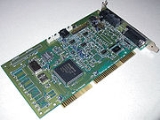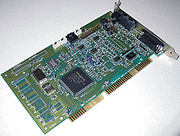
Creative Wave Blaster
Encyclopedia

Musical Instrument Digital Interface
MIDI is an industry-standard protocol, first defined in 1982 by Gordon Hall, that enables electronic musical instruments , computers and other electronic equipment to communicate and synchronize with each other...
-synthesizer for Creative
Creative Technology
Creative Technology Ltd. is a Singapore-based global company headquartered in Jurong East, Singapore. The principal activities of the company and its subsidiaries consist of the design, manufacture and distribution of digitized sound and video boards, computers and related multimedia, and personal...
Sound Blaster 16
Sound Blaster 16
The Sound Blaster 16 is a series of sound cards by Creative Technology. They are add-on boards for PCs with an ISA or PCI slot.-Sound Blaster 16:Sound Blaster 16 , the successor to the Sound Blaster Pro, introduced 16-bit digital audio sampling to the Sound Blaster line...
, Sound Blaster AWE32
Sound Blaster AWE32
Sound Blaster AWE32 is an ISA sound card from Creative Technology. It is an expansion board for PCs. The Sound Blaster AWE32, introduced in March 1994, was a near full-length ISA sound card, measuring 14 inches in length, due to the number of features included.-MIDI capability:The Sound Blaster...
, and AWE64 family of PC soundcards. It was a sample-based synthesis
Sample-based synthesis
Sample-based synthesis is a form of audio synthesis that can be contrasted to either subtractive synthesis or additive synthesis. The principal difference with sample-based synthesis is that the seed waveforms are sampled sounds or instruments instead of fundamental waveforms such as the saw waves...
General MIDI
General MIDI
General MIDI or GM is a standardized specification for music synthesizers that respond to MIDI messages. GM was developed by the MIDI Manufacturers Association and the Japan MIDI Standards Committee and first published in 1991...
compliant synthesizer. For General MIDI scores, the Wave Blaster's wavetable-engine produced more realistic instrumental music than the SB16's onboard Yamaha-OPL3.
The Wave Blaster attached to a SB16 through a 26-pin expansion-header, eliminating the need for extra cabling between the SB16 and the Wave Blaster. The SB16 emulated an MPU-401 UART, giving existing MIDI-software the option to send MIDI-sequences directly to the attached Wave Blaster, instead of driving an external MIDI-device. The Wave Blaster's analog stereo-output fed into a dedicated line-in on the SB16, where the onboard-mixer allowed equalization, mixing, and volume adjustment.
The Wave Blaster port was adopted by other sound card manufacturers who produced both daughterboards and soundcards with the expansion-header: Yamaha, Ensoniq
Ensoniq
Ensoniq Corp. was an American electronics manufacturer, best known throughout the mid 1980s and 1990s for its musical instruments, principally samplers and synthesizers.- Company history :...
, Orchid
Orchid Technology
Orchid Technology was a privately held company founded by Le Nhon Bui in 1982. The company's original flagship product was its PCNet card, a 1 megabit-per-second LAN card for IBM PCs and clones. Notably, the acronym LAN is the Vietnamese word for "Orchid"...
, Oberheim
Oberheim
Oberheim Electronics is an American company, founded in 1969 by Tom Oberheim , which manufactured audio synthesizers and a variety of other electronic musical instruments.-Oberheim Electronics:...
, Guillemot, Diamond
Diamond Multimedia
Diamond Multimedia is a company that specializes in many forms of multimedia technology. They have produced graphics cards, motherboards, modems, sound cards and MP3 players, however the company began with the production of the TrackStar, a PC add-on card which emulated Apple II computers...
, TerraTec
TerraTec
TerraTec Electronic GmbH is a German manufacturer of sound cards, computer speakers, webcams, computer mice, video grabbers and TV tuner cards....
, Roland
Roland Corporation
is a Japanese manufacturer of electronic musical instruments, electronic equipment and software. It was founded by Ikutaro Kakehashi in Osaka on April 18, 1972, with ¥33 million in capital. In 2005 Roland's headquarters relocated to Hamamatsu in Shizuoka Prefecture. Today it has factories in Japan,...
, and Turtle Beach
Turtle Beach Systems
Turtle Beach Systems is a sound card and headphone manufacturer and direct competitor with Creative Labs-branded Sound Blaster. In 1995, the company merged with Voyetra, a company that made custom software for sound cards, to form Voyetra Turtle Beach Inc which is headquartered in Elmsford, New...
. The header also appeared on devices such as the Korg
Korg
is a Japanese multinational corporation that manufactures electronic musical instruments, audio processors and guitar pedals, recording equipment, and electronic tuners...
NX5R MIDI sound module, the Oberheim MC-1000/MC-2000 keyboards, and the TerraTec Axon AX-100 Guitar-to-MIDI converter.
Although new Wave Blaster-capable sound cards for computers haven't been produced for years, Terratec still produces their Axon AX-100 Guitar-to-MIDI converter that uses a Wave Blaster port to add sound generation capability. In 2005, they released a new Wave Blaster daughterboard called the Wave XTable with 16mb of on-board sample memory comprising 500 instruments and 10 drum kits.
WaveBlaster II
Creative released the Waveblaster II shortly after the original Waveblaster. Waveblaster II used a newer EMU-8000 synthesis-engine (which later appeared in the AWE32). Despite using a smaller 2MB instrument ROM (vs 4MB of the original Waveblaster), the Waveblaster II delivered better renditions in most MIDI-scored games, likely due to better sample refinement and balancing between instruments.While the original Waveblaster greatly improved upon the acoustic quality of the SB16's built-in FM-synthesis, the acoustic quality of its instrument-set was poorly regarded. By the time the SB16 reached the height of its popularity, competing MIDI-daughterboards had already pushed aside the Waveblaster. In particular, Roland's Sound Canvas daughterboards (SCD-10/15), priced only slightly more than Creative's offering, were highly regarded for their unrivalled musical reproduction in MIDI-scored game titles. (This was due to Roland's dominance in the production aspect of the PC game soundtracks; Roland's daughterboards shared the same synthesis-engine and instrument sound-set as the popular Sound Canvas 55, a commercial MIDI module favored by game composers.) By comparison, the WaveBlaster's instruments were improperly balanced, with many instruments striking at different volume-levels (relative to the de-facto standard, Sound Canvas.)
WaveBlaster Connector Pinout
| Pin | Function | Pin | Function |
|---|---|---|---|
| 1 | DGnd | 2 | |
| 3 | DGnd | 4 | TTL-MIDI input |
| 5 | DGnd | 6 | |
| 7 | DGnd | 8 | TTL-MIDI output |
| 9 | DGnd | 10 | |
| 11 | DGnd | 12 | Audio R in |
| 13 | |||
| 14 | |||
| 15 | AGnd | 16 | Audio L in |
| 17 | AGnd | 18 | |
| 19 | AGnd | 20 | Audio R out |
| 21 | AGnd | 22 | |
| 23 | AGnd | 24 | Audio L out |
| 25 | AGnd | 26 | !Reset |
- AGnd = Analog ground
- DGnd = Digital ground
- Some Wave Blaster cards offer audio inputs ( Yamaha DB60XG )
- Some Wave Blaster cards offer TTLTransistor-transistor logicTransistor–transistor logic is a class of digital circuits built from bipolar junction transistors and resistors. It is called transistor–transistor logic because both the logic gating function and the amplifying function are performed by transistors .TTL is notable for being a widespread...
-MIDI output - Reset is active low

